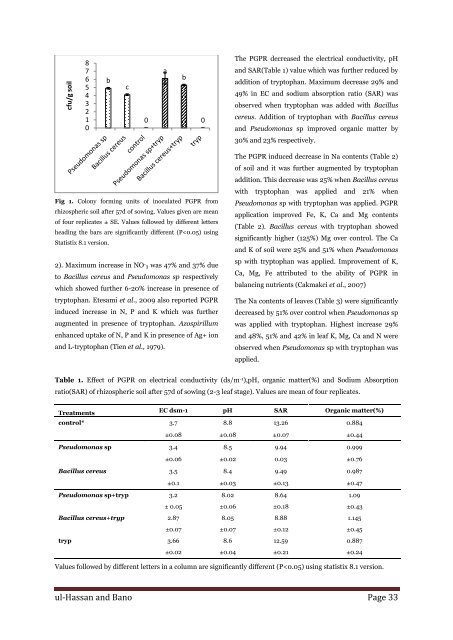Role of plant growth promoting rhizobacteria and L-tryptophan on improvement of growth, nutrient availability and yield of wheat (Triticum aestivum) under salt stress
During the present study Pseudomonas sp and Bacillus cereus isolated from rhizospheric soil of halophytic weeds of Khewra salt range were used as bioinoculant on wheat. Aqueous solution of tryptophan was added to the rhizospheric soil @1ug/L after seed germination. Experiment was conducted at Quaid-i-Azam University Islamabad in pots under sterilized condition. Electrical conductivity (EC) was maintained to 3.7 dsm-1 by applying 150mM NaCl twice (after 7 and 14d of seed germination). PGPR inoculation significantly decreased EC, pH, SAR, Na, and Cl contents and improved K, Ca, Mg, Fe, P, NO3 and organic matter contents of the rhizospheric soil. Tryptophan addition assisted the PGPR to further decrease the EC, SAR and improved nutrients uptake and growth. Tryptophan augmented the PGPR-induced increase in fresh weight, chlorophyll, proline and sugar contents. Superoxide dismutase and peroxidase activities of leaves of inoculated plants were also higher in the presence of tryptophan. Greater production of abscisic acid and Indole acetic acid were recorded in leaves of PGPR inoculated plants and addition of tryptophan augmented the phytohormone production in leaves of treated plants. Inoculation of PGPR alone and with tryptophan positively affected the yield of crop by improving seed establishment and number of seeds/spike.
During the present study Pseudomonas sp and Bacillus cereus isolated from rhizospheric soil of halophytic weeds of Khewra salt range were used as bioinoculant on wheat. Aqueous solution of tryptophan was added to the
rhizospheric soil @1ug/L after seed germination. Experiment was conducted at Quaid-i-Azam University Islamabad in pots under sterilized condition. Electrical conductivity (EC) was maintained to 3.7 dsm-1 by applying 150mM NaCl twice (after 7 and 14d of seed germination). PGPR inoculation significantly decreased EC, pH, SAR, Na, and Cl contents and improved K, Ca, Mg, Fe, P, NO3 and organic matter contents of the
rhizospheric soil. Tryptophan addition assisted the PGPR to further decrease the EC, SAR and improved nutrients uptake and growth. Tryptophan augmented the PGPR-induced increase in fresh weight, chlorophyll, proline and sugar contents. Superoxide dismutase and peroxidase activities of leaves of inoculated plants were also higher in the presence of tryptophan. Greater production of abscisic acid and Indole acetic acid were recorded in leaves of PGPR inoculated plants and addition of tryptophan augmented the phytohormone production in leaves of treated plants. Inoculation of PGPR alone and with tryptophan positively affected the yield of crop by improving seed establishment and number of seeds/spike.
You also want an ePaper? Increase the reach of your titles
YUMPU automatically turns print PDFs into web optimized ePapers that Google loves.
cfu/g soil<br />
8<br />
7<br />
6<br />
5<br />
4<br />
3<br />
2<br />
1<br />
0<br />
b<br />
c<br />
0<br />
a<br />
b<br />
0<br />
The PGPR decreased the electrical c<strong>on</strong>ductivity, pH<br />
<str<strong>on</strong>g>and</str<strong>on</strong>g> SAR(Table 1) value which was further reduced by<br />
additi<strong>on</strong> <str<strong>on</strong>g>of</str<strong>on</strong>g> <str<strong>on</strong>g>tryptophan</str<strong>on</strong>g>. Maximum decrease 29% <str<strong>on</strong>g>and</str<strong>on</strong>g><br />
49% in EC <str<strong>on</strong>g>and</str<strong>on</strong>g> sodium absorpti<strong>on</strong> ratio (SAR) was<br />
observed when <str<strong>on</strong>g>tryptophan</str<strong>on</strong>g> was added with Bacillus<br />
cereus. Additi<strong>on</strong> <str<strong>on</strong>g>of</str<strong>on</strong>g> <str<strong>on</strong>g>tryptophan</str<strong>on</strong>g> with Bacillus cereus<br />
<str<strong>on</strong>g>and</str<strong>on</strong>g> Pseudom<strong>on</strong>as sp improved organic matter by<br />
30% <str<strong>on</strong>g>and</str<strong>on</strong>g> 23% respectively.<br />
Fig 1. Col<strong>on</strong>y forming units <str<strong>on</strong>g>of</str<strong>on</strong>g> inoculated PGPR from<br />
rhizospheric soil after 57d <str<strong>on</strong>g>of</str<strong>on</strong>g> sowing. Values given are mean<br />
<str<strong>on</strong>g>of</str<strong>on</strong>g> four replicates ± SE. Values followed by different letters<br />
heading the bars are significantly different (P


















